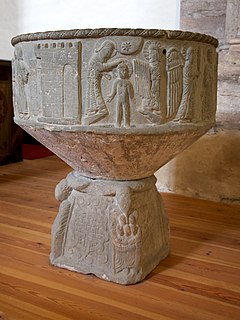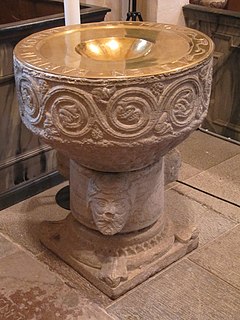Gallery
- Font in Stånga church, Gotland
- Font in Halla church, Gotland
- Font in När church, Gotland
- Choir portal of Fardhem church, Gotland
Hegvald (also Hegwald, Hegwaldr, fl. c. 1175-1200) was a Romanesque stone sculptor of baptismal fonts, working on Gotland. [1]
The name of Hegvald is derived from a rune inscription on one of the baptismal fonts attributed to the sculptor, but the name may also be that of a patron. On stylistic grounds, 11 baptismal fonts on Gotland have been attributed to the, in effect, anonymous master sculptor. He seems to have started as an apprentice in the workshop of the somewhat earlier Majestatis. [1] His style is characterised by its mix between classic Romanesque and lingering Norse influences. The works attributed to Hegvald are expressive on the verge of grotesque, somewhat vernacular and typically sculpting covers the whole of the font, including the base and foot. [1] [2] [3] [4]
Baptismal fonts from his atelier can be found in När, Sjonhem, Stånga, Halla and Etelhem churches, all on Gotland, as well as in the Swedish Museum of National Antiquities in Stockholm. He is also attributed as the artist of a triumphal cross in Vänge Church, also on Gotland. [2] [4] The choir portal of Fardhem Church is also attributed to Hegvald. [1]

Sigraf was a Romanesque stone sculptor, working on Gotland. He was mainly active as a sculptor of baptismal fonts, but also of reliquaries, carved pillars and reliefs. He was the most productive of several early medieval stone sculptors making baptismal fonts on Gotland.

Majestatis was a Romanesque stone sculptor and the creator of several richly decorated baptismal fonts mainly in Scania and on Gotland.
Byzantios is the notname of a Romanesque stone sculptor or workshop, working on Gotland in present-day Sweden during the last quarter of the 12th century. Byzantios was the first of a series of Romanesque stone sculpture workshops active on Gotland. Around a dozen decorated baptismal fonts from this time are so similar in style and execution that art historians have assumed they have the same origin. The artist has thus been labelled Byzantios. However, they may also have been made by a workshop and not by a single individual. Likewise, the origins and precise artistic roots of Byzantios are not known, but there is a general agreement on that the art of Byzantios show influences from Byzantine art of the period; hence the notname.

Grötlingbo Church is a medieval church in Grötlingbo on the Swedish island Gotland. The stately Gothic church contains elements of a Romanesque frieze, incorporated from an earlier church building on the same site. Görtlingbo Church lies within the Diocese of Visby.

Tingstäde Church is a medievalchurch on the Swedish island of Gotland, in the Diocese of Visby. Its present appearance dates largely from the 13th and 14th centuries.

Alva Church is a medieval church in Alva on the Swedish island of Gotland. The oldest parts of the church date from the late 12th century; with the halted construction of the tower about a century later, building activity ceased. The church contains medieval murals as well as a number of medieval furnishings and pieces of art. It lies in the Diocese of Visby of the Church of Sweden.

Stånga Church is a medieval church in Stånga on the Swedish island of Gotland. The site of the church has probably been considered sacred since before the Christianization of Scandinavia.

Etelmhem Church is a medieval church on the Swedish island of Gotland. The largely Gothic church contains medieval murals and a 12th-century baptismal font by the sculptor Hegvald. The church is used by the Church of Sweden and part of Diocese of Visby.

Fardhem Church is a medieval church in Fardhem on the Swedish island of Gotland. The present-day church may have been preceded by a stave church; the current church is one of the most well-preserved Romanesque churches on Gotland, built in stages from the 12th to 13th century. It belongs to the Church of Sweden and lies in the Diocese of Visby.

Ekeby Church is a medieval church in Ekeby on the Swedish island of Gotland. The oldest parts date from the 12th century, and the church has been little altered since the end of the 13th century. Its interior is richly decorated with medieval murals. It belongs to the Church of Sweden and lies in the Diocese of Visby.

Ganthem Church is a well-preserved Romanesque church in Ganthem on the island of Gotland. It contains murals from the 15th century as well as a number of medieval furnishings. It lies in the Diocese of Visby (Sweden).

Halla Church is a medieval church in Halla on the Swedish island Gotland. It is part of the Diocese of Visby.

Norrlanda Church is a medieval church on the Swedish island Gotland, in the Diocese of Visby.

När Church is a medieval church on the Swedish island Gotland. It belongs to the Church of Sweden and lies in the Diocese of Visby.

Gerum Church is a medieval church in Gerum on the Swedish island of Gotland, built between c. 1200 and 1300. It is used by the Church of Sweden.

Vall Church is a medieval church on the Swedish island of Gotland. The largely Romanesque church dates from the 13th century. It belongs to the Diocese of Visby.

Sjonhem Church is a medieval church on the island of Gotland, Sweden. It belongs to the Diocese of Visby.

Vänge Church is a medieval church in Vänge on the island of Gotland, Sweden. Its oldest parts date to circa 1200. It belongs to the Diocese of Visby.

Calcarius was an artist working in late Romanesque style on Gotland.

Viklau Church is a medieval church on Gotland, Sweden. It is a well-preserved Romanesque church in which several medieval items have been preserved. The most famous of these is the Viklau Madonna, today housed in the Swedish History Museum in Stockholm.